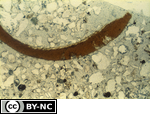Download Image
5.38 MB

ID # 248
Monie related distribution patternFrom the Soil Micromorphology Slide Collection
STEM Standard addressed: ESS2E - Biogeology
Appropriate Grade Level(s)
- College-level
- Classroom Lectures
- Laboratory Activities
- Soil Microbiology
Data for the horizon Horizon sampled: A 1 Depth sampled: 0-15 cm
Macromorphological description of horizon: 1OYR 5/3 loamy fine sand, 1OYR 3/3 moist, weak medium granular structure, many fine roots
Micromorphological description of horizon: Most of the particles are sands that serve as the soil skeleton. Not enough silt and clay are present to bridge the skeleton grains. The resulting pattern of coarse and fine patterns is named manic by Stoops and Jongerius (1975) and orthogranic by Brewer, Sleeman and Foster (1983).
Many of the pores are as large as 0.1 mm in diameter. Such pores would be drained at soil moisture tensions of 30 mbar or at near field capacity. The earthworm shown is about 0.2 mm in diameter also. Channels formed by its activity would also be drained at low tension unless blocked by erosion of material from their side walls. Most of the skeleton grains are quartz and plagioclase.
Data for thin section
Preparation of sample: Air dry
Thickness of section: 30 µm
Size of section: 25x40 mm
Soil Classification
U.S.: Sandy, mixed, thermic Psammentic Haplustalf
Legal description: 350 m W and 215 m N of the southeast corner of section 1, T25S, R 19W Elevation: 672 m above mean sea level
Physiographic position: Undulating upland dune Topography and hill slope position: Backslope Parent material: Eolian sand
Soil climatic data and/or soil water balance: Ustic moisture regime; thermic temperature regime Vegetation: Cropland
Climate: Mean annual precipitation 63 cm; mean annual temperature 13 degrees C
Macromorphological description of horizon: 1OYR 5/3 loamy fine sand, 1OYR 3/3 moist, weak medium granular structure, many fine roots
Micromorphological description of horizon: Most of the particles are sands that serve as the soil skeleton. Not enough silt and clay are present to bridge the skeleton grains. The resulting pattern of coarse and fine patterns is named manic by Stoops and Jongerius (1975) and orthogranic by Brewer, Sleeman and Foster (1983).
Many of the pores are as large as 0.1 mm in diameter. Such pores would be drained at soil moisture tensions of 30 mbar or at near field capacity. The earthworm shown is about 0.2 mm in diameter also. Channels formed by its activity would also be drained at low tension unless blocked by erosion of material from their side walls. Most of the skeleton grains are quartz and plagioclase.
Data for thin section
Preparation of sample: Air dry
Thickness of section: 30 µm
Size of section: 25x40 mm
Soil Classification
U.S.: Sandy, mixed, thermic Psammentic Haplustalf
Legal description: 350 m W and 215 m N of the southeast corner of section 1, T25S, R 19W Elevation: 672 m above mean sea level
Physiographic position: Undulating upland dune Topography and hill slope position: Backslope Parent material: Eolian sand
Soil climatic data and/or soil water balance: Ustic moisture regime; thermic temperature regime Vegetation: Cropland
Climate: Mean annual precipitation 63 cm; mean annual temperature 13 degrees C
Method
Data for 35-mm slide
Magnification: 10 x
Light mode: Plane polarized
Magnification: 10 x
Light mode: Plane polarized
References
Unpublished report of the National Soil Survey Laboratory. USDA-SCS, Lincoln, NE. Source - W.D. Nettleton
Slide RDP1. Soil Science Society of America, 1993. A Reference Slide Collection for Soil Micromorphology. SSSA, Madison, WI.
Slide RDP1. Soil Science Society of America, 1993. A Reference Slide Collection for Soil Micromorphology. SSSA, Madison, WI.
Peer Review: Yes
Credit this item to: SSSAMedia Date: 1993-01-01
Provided By: (SSSA) Soil Science Society of America
Latitude: 37.865958
Longitude: -99.27855829999999
Author(s)/Creator(s)
-
* Soil Science Society of America
SSSA
Submitted By: (SSSA) Soil Science Society of America
Keywords
- Related Distribution Patterns
- A 1 horizon
- micromorphology
- Monie related distribution pattern
Comments
Please login to submit a comment.
Log In to your account
Already a member, certified, or existing customer?*
* Cookies must be accepted to log in.
Not sure if you have an account?
Check Your Email
Join Us!
Connect with members and access the information you need.
Learn more.
Ready to Join?
If you have an account, login on the left. Not sure if you have an account or need to create one? Check your email with the link above. We look forward to welcoming you.